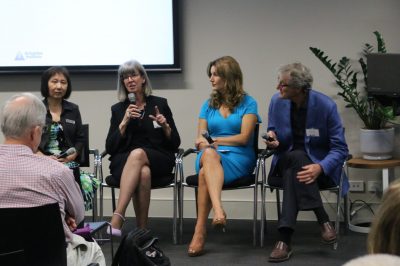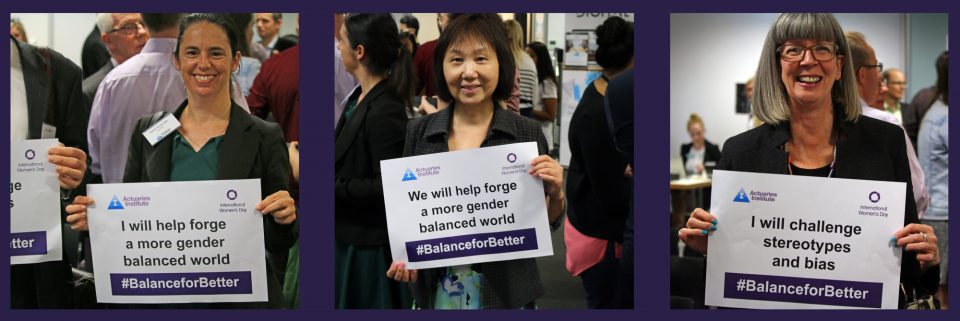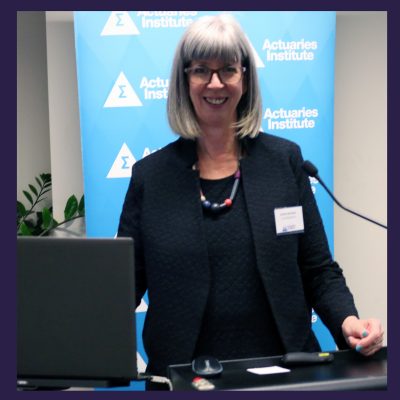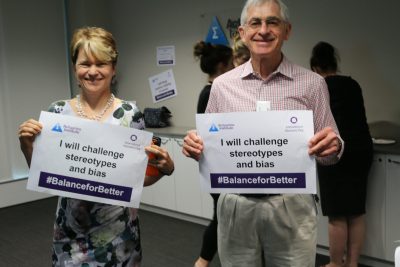
Fact vs Fiction: Gender Diversity in STEM
At this special Insights session for International Women’s Day, the focus was on the low uptake of advanced mathematics by girls in school. It explored the causes of low STEM uptake among school students, the implications, and what we can do about it. Lucky Joeng was in the audience.
On 8 March 2019, to celebrate International Women’s Day, Lesley Traverso, as the facilitator, introduced presenters Nicolette Rubinsztein (President, Actuaries Institute), Professor Russell Tytler (Chair in Science Education, Deakin University), Dr Ning Li (Gender researcher, CHOOSEMATHS) and Janine McIntosh (Schools Program Manager, AMSI) to an audience at the Actuaries Institute in Sydney.
Nicolette welcomed the audience and was encouraged to see an equal number of male and female attendants. Addressing gender diversity issues in STEM requires collaboration from everyone. In her Presidential Address, Nicolette focused on gender diversity and this forms part of one of the Institute’s Strategic Goals (Growth & Diversity). To achieve this key goal she identified two key areas to address:
- the low uptake of advanced mathematics by girls in school; and
- why many female actuaries don’t progress to Fellowship and are not promoted into senior roles.
This Insight session focused on the first key area.
Low uptake of mathematics and its implication
Australia ranks poorly in science and mathematics when compared to other OECD nations. Although there was a focus on girls’ participation in STEM during the 1990s, it subsequently slipped off the agenda. This, combined with other factors such as lack of STEM teachers causes a lower uptake of advanced mathematics amongst school students, leading to fewer girls taking STEM subjects. According to the latest available statistics:
- 9% of girls and 12.2% of boys take advanced mathematics.
- 20% of girls and 18.9% of boys take intermediate mathematics.
- Girls make up 38% of advanced mathematics and 53% of intermediate mathematics

Low STEM uptake by students has future implications for the individuals themselves and for the Australian economy. Students lacking in STEM skills will have less job opportunities available as professional jobs are becoming more and more technically demanding. From a macro perspective, Australia needs its workforce to have strong STEM skills to maintain economic growth and keep up with competition from other countries

What’s the causes of the low STEM uptake amongst school students?
Cultural perspective
- In Australia there is a belief that only the naturally talented can do well in STEM. But overseas, such as in East Asian countries, students believe that hard work and persistence plays a much larger role in enabling them to do well in STEM subjects
- Parents and teachers’ unconscious biases may create an impression that STEM is more appropriate for boys. For example, parents tend to give science toys to boys more frequently than to girls, this can make girls feel that STEM is not for them therefore less girls take up mathematics and science in school
Logistics
- In Australia, there is a lack of teachers specialising in STEM, this forces schools to assign other teachers to fill in the role, even though they have no experience in teaching STEM subjects
- Because of low female participation in STEM careers, there is a lack of role models for girls, which in turn causes even lower female participation in STEM careers
- Mathematics is not compulsory for most university degrees, so there is little incentive for students to take up STEM subjects in school even though they have the aptitude for the subjects
- Content and structure of STEM subjects are often based on boys’ learning style, making girls feel unrelatable to the subjects so they to lose interest quickly
Is there inherent difference between girls and boys?
- There is no physiological difference between male and female brains and capabilities in analytical subjects
- NAPLAN results showed no difference between girls and boys until Year Three level when it comes to mathematics performance.
- In later years however, NAPLAN results showed boys do perform better in mathematics while girls perform better in reading
- This is not because girls are less able in mathematics, but because they are less confident in their self-perceived ability to learn mathematics
- However, socio-economic background and home learning resources has much stronger impact on both girls’ and boys’ performance in mathematics
What can we do to address this?
- Enable parents and teachers to be more aware of their unconscious bias on STEM career, as it can unintentionally stereotype STEM careers as more suitable for boys
- Start helping children struggling with maths earlier on, as the child’s decision to continue learning advanced mathematics is heavily based on their previous results and achievements
- Awareness – AMSI promotes careers in STEM by featuring biographies of STEM professionals on its website, one featured professional is a Fellow of the Actuaries Institute, Solia Valliappan. The online biography describes their learning journey and why they decided on their career path
- Actuaries Institute relaunched the ‘See What we see’ campaign to promote actuarial profession by showcasing what actuaries do and why the role is essential in society
Extra note from Lucky:
From my experience tutoring science and mathematics, it seems that there is little incentive for students to take up science and higher mathematics as universities don’t have them as pre-requisites. However, this is changing as universities (such as Sydney University) have made mathematics advanced (for NSW students) a pre-requisite for some of the degrees especially the STEM based ones
References
-
Gender Report 2017: Participation, Performance and Attitudes towards Mathematics, ChooseMATHS, https://schools.amsi.org.au/2017/11/14/gender-report-2017/
-
STEM: Country Comparison, Australian Council of Learned Academies, https://acola.org.au/wp/project-2/
-
Girls’ Future – Our Future, The Invergowrie Foundation STEM Report, The Invergowrie Foundation, http://www.invergowrie.org.au/girls-future-our-future-the-invergowrie-foundation-stem-report/
-
Year 12 mathematics participation in Australia 2008 – 2017, AMSI, https://amsi.org.au/publications/year-12-mathematics-participation-in-australia-2008-2017/
-
Solai Valliappan, AMSI careers, https://careers.amsi.org.au/solai/
-
Actuaries Institute, See What We See campaign, https://www.actuaries.asn.au/microsites/see-what-we-see
CPD: Actuaries Institute Members can claim two CPD points for every hour of reading articles on Actuaries Digital.











